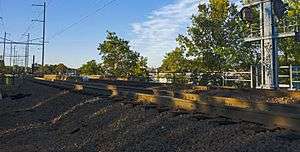Woodbridge train derailment
The Woodbridge train derailment occurred on February 6, 1951, in Woodbridge, New Jersey, when a train derailed crossing a temporary wooden trestle, killing 86 people. It remains New Jersey's deadliest train wreck, the deadliest U.S. derailment since 1918, and the deadliest peacetime rail disaster in the United States.[1]
| Woodbridge train derailment | |
|---|---|
 Accident site in 2016 | |
| Details | |
| Date | February 6, 1951 5.43 pm |
| Location | Woodbridge, New Jersey |
| Country | United States |
| Line | North Jersey Coast Line |
| Operator | Pennsylvania Railroad |
| Incident type | Derailment at diversion |
| Cause | Excessive speed |
| Statistics | |
| Trains | 1 |
| Deaths | 85 |
| Injuries | 500 |
Around 5 p.m. on February 6, 1951, Pennsylvania Railroad Train No. 733 left Exchange Place in Jersey City. An express train to Bay Head via the North Jersey Coast Line, 733 was crowded that day due to a strike on the nearby Jersey Central Railroad. It carried over 1,000 passengers[2] in 11 cars drawn by PRR K4s 4-6-2 steam locomotive 2445.[3]
That afternoon, rail traffic through Woodbridge was being diverted onto a temporary wooden trestle and a shoofly near Fulton Street, allowing laborers building the New Jersey Turnpike to work on the main line. A notice had gone out to train engineers in late January: after 1:01 p.m. on February 6, they were to proceed through Woodbridge not at the normal 60 mph (97 km/h) but at 25 mph (40 km/h).[4]
Before Train No. 733 left Jersey City, its conductor reminded engineer Joseph Fitzsimmons about the speed restriction. Fitzsimmons failed to slow the train as it approached Woodbridge. About a mile before the town, the conductor, alarmed at the train's speed, tried to pull the emergency cord, but the crush of passengers made it impossible.[4]
The train was traveling faster than 50 mph (80 km/h) when it hit the curve approaching the trestle, according to a subsequent inquiry. At 5:43 p.m., the tracks shifted under the massive locomotive, and eight of the train's 11 cars derailed. The first two cars fell on their sides. The third and fourth cars crashed into each other as they hurtled down a 26-foot-high (7.9 m) embankment.[5] It was in these two cars that most of the 85 deaths occurred. The fifth and sixth cars were left hanging in mid-air over a street that glistened from rain. Some passengers may have jumped to their deaths, believing they would land in water.[6] The accident occurred in a heavily populated area, so help soon arrived. Neighbors opened their houses to those in need. The critically injured were taken to the hospital.
Although Fitzsimmons claimed that he had been travelling at only 25 mph (40 km/h), the inquiry estimated that the speed was between 50 and 60 mph (80 and 97 km/h). The report concluded that the wreck was caused by "intense speed on a curve of a temporary track". Fitzsimmons continued working for the railroad, but never operated a train again.[2]
See also
- List of American railroad accidents
- List of rail accidents (1950–59)
References
- "THE NATION; Disaster at Woodbridge Worst Since 1918 The Whys 18-Year-Olds--Maybe What Fiscal Policy? Federal Reserve Issue The Arguments R.F.C. Under Fire Mr. Truman's Reaction Remington: Guilty Defense Testimony". The New York Times. February 11, 1951. Retrieved September 18, 2018.
- https://web.archive.org/web/20080725001302/http://www.woodbridgefdnj.org/History/Wreck/SL/sl.htm. Archived from the original on July 25, 2008. Retrieved June 11, 2010. Missing or empty
|title=(help) - "Locomotive image". Angelfire.com. Retrieved 2014-02-05.
- https://web.archive.org/web/20080725001358/http://www.woodbridgefdnj.org/History/Wreck/THNT/thnt3.htm. Archived from the original on July 25, 2008. Retrieved June 11, 2010. Missing or empty
|title=(help) - "SPAN JUST OPENED; SCENES OF FATAL TRAIN WRECK WHICH TOOK HEAVY TOLL". The New York Times. February 7, 1951. Retrieved September 18, 2018.
External links
- Color photo of the scene the day after the accident
- The Woodbridge Train Wreck
- ICC Report, Transcription available via DOT library